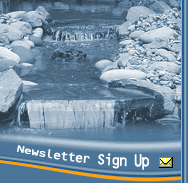 |

Downs By The Pond
86663 Bailey Hill Road
Eugene, OR 97405
Phone: 541-521-7389
Email
Us
|
|
|
Problem Solving
- Green Water and Other Algae
- Leaks
- Predators
1.Green Water and Other
Algae Top
Green water is one of the most common complaints we hear about ponds.
Green water is caused by the bloom of microscopic one-celled algae-
algae at it's most basic. String algae is a common problem in waterfalls
and streams. It grows rapidly and can quickly get out of control.
A number of factors can encourage the growth of algae. A few items
to check are:
Overfeeding of fish: any food which is not consumed by the fish,
or removed by a net, will drop to the bottom of the pond, it will
decompose and become a source of nutrient for the algae. Only feed
what can be consumed in 5 minutes.
Plants population: It is recommended that 50-60% of the pond surface
be covered with plants. Especially important are oxygenators. All
plants will compete with algae for any available nutrient in the
pond.
Frequent water changes: Fighting green water by changing the water
will only lead to increased green water problems. Fresh water contains
many nutrients and minerals which will only help the algae to thrive.
Fish load: Overstocking of fish or lack of an adequate biological
filter can lead to excess build up of ammonia and nitrate in the
pond which in turn feeds the algae.
Low dissolved oxygen: A lack of oxygen caused by too little aeration
can also contribute to algae problems by slowing down bacterial decomposition
of nutrient producing organic waste.
As mentioned, ultraviolet sterilizers are very effective for killing
algae spores of green water algae.
Fountec is a great product for string algae control in birdbaths,
fountains and ponds with no fish. Because of the nature of the product,
it will smother fish by coating their gill plates. It is safe for
birds, dogs, cats and other animals.
|
|
2.Leaks Top
Ponds quite often appear to have leaks because of a noticeable water
loss. In many instances, the real trouble lies in misdirected water
in the waterfalls or stream or water lost to evaporation. Another
problem may be the liner is folded too low or rocks may have settled
causing the liner to sag.
Ways to identify the causes are:
Turn off all moving water in streams and falls. Fill the pond. Use
a little lipstick or grease pencil to draw a small line on the liner
or stone at the level of the water. Check in 12-24 hours to see if
the water level has changed. If the water level is stable, you will
know to look in the fall or stream.
Waterfalls and streams require a visible inspection. Turn on the
pump and let the system run for several hours,longer if possible.
You may now inspect for leaks by looking for noticeably soggy areas
on the edges outside of the lining. You should also check for piles
of debris such as leaves or algae which may be impeding the stream
flow. In most circumstances you will find that either there is a
great deal of splash or the liner has settled.
If a hole is found, it can be repaired using the seam tape as a patch.
It is very important to clean the liner well and to place a firm
backing behind the area of the liner to be patched. You can then
firmly press the patch for the best adhesion.
|
|
3.Predators Top
Herons are lovely to behold, however they can e very frustrating
for the fish keeper. A pond with fish should be at least 30 deep
in some areas to help prevent heron attacks. Herons will not go into
the water deeper than their knees because they cannot fly away quickly
if threatened. Heron Decoys in natural colors seem to be more of
a deterrent than bronze cranes, but either should be moved occasionally.
Raccoons can tear apart a pond quickly. Often they are looking for
grubs in plants as well as the fish. Shelves that are dug at least
15-18 will help keep them from getting the fish from your pond, as
they generally fish from the edges. A small electric fence is a good
investment for around the pond.
Scarecrow sprinklers are helpful for both herons and raccoons. These
sprinklers are motion activated and set off a short burst of water
from the attached rain bird.
Pests
Aphids, which arrive in late spring or early summer are the main
problem for aquatic plants. Aphids are attracted to the color yellow
and it is important to remove yellow or yellowing leaves from water
lilies and other plants. Removing these leaves has the additional
benefit of making the pond look better, promoting new growth, and
helping reduce decaying organic matter in the pond. Herbal Aphid
Control (by Aquarium Pharmaceuticals) seems to work the best of the
products on the market and is fish safe. Aphids can also be rinsed
off the leaves so that the fish snack on them. In most cases this
is not effective.
Mosquitoes are becoming more of a problem As mosquitoes lay their
eggs in stagnant water, we encourage everyone to keep the water in
their pond moving. Additionally, Gambusia (tiny mosquito larvae eating
fish) or Mosquito Dunk can used effectively to help control this
pest.
|
|
|
|
|











